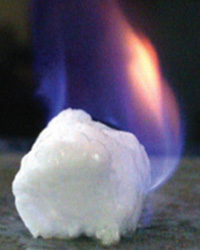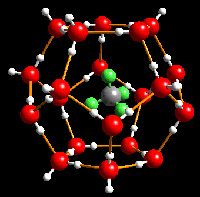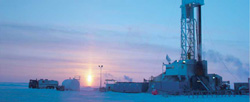Threat or Promise? The complexity of methane hydrates
on
Threat or Promise? The complexity of methane hydrates
They provide the plot for the destruction of the world in numerous films and novels through extremely rapid climate change and violent explosions. Equally however, they offer the possibility for a truly gigantic increase in potentially useful natural gas reserves transforming our perceptions of the resource. In addition, they might offer a cheaper way of transporting gas than LNG. The trouble is that methane hydrates, “clathrates or “ice”, are too little researched and nobody is clear which they offer; a threat or a promise.
 |
| Burning methane hydrates |
| Article Highlights: |
| - Methane hydrates, solid molecules trapped in water, exist in huge quantities on or underneath the ocean floor in various parts of the world. |
| - They could potentially expand global gas reserves by 5 to 28 times and, if extracted succesfully, would transform the global geopolitical energy scene. |
| - If released in large quantities, they could also serve as a strong greenhouse gas, upsetting the global climate. |
| -Countries like the US, Japan and India are conducting research into methane hydrates, but much more research is needed to find out what threats and benefits this strange resource could offer to mankind. |
Subsequently, he went on to point out that the amount of methane stored beneath the Siberian shelf could be of the order of 2,000 Gt (Gigatonnes). (For good measure: global gas production was some 2.5 Gt of oil equivalents in 2005.) Not all of this methane is in the form of methane hydrates, but the bulk of it is. If just 1% of this methane store was released, it would push total atmospheric methane above six parts per million from 1.7 parts per million now. Given that methane is a greenhouse gas twenty-one times more potent than carbon dioxide, this would be very bad news indeed for the planet. In effect 1 kilo of methane has the same effect as 212 kilos of CO2.
Trapped in the water
Clathrate hydrates are, effectively, gas trapped molecules in a lattice of water molecules. They are not simply methane formations, but can contain many other gases as well, such as hydrogen sulphide, oxygen, hydrogen and carbon dioxide. (Creating carbon dioxide hydrates has been seen as a potential form of carbon capture.) They are not that well understood at the molecular level, but their composition is not the result of any kind of chemical reaction.
The gas molecule is simply trapped in the water, forming a solid, which looks a great deal like ice. If the gas is released the solid structure collapses. In the case of methane hydrates, one litre of hydrate contains about 168 litres of gaseous methane. They are stable at 40 atmospheres of pressure and 5°C and below. To get these conditions in the sea, a depth of over 400 metres is needed, depending on seawater temperature. In effect, the hydrates can be formed either from biologically-created methane from decaying matter on the seabed and from much older migrating gas from deep deposits hitting the seawater.
In spite of being first observed by Sir Humphrey Davy in 1810, the closest most petroleum engineers normally get to hydrates is as an irritating nuisance. They can form under certain conditions of temperature and pressure blocking gas pipelines and gas processing equipment. Away from such conventional hydrocarbon systems, methane hydrates were thought to be comparatively rare in the 1950s.
However, research in the 1970s seemed to suggest that they were just about everywhere under the sea or Arctic ice and permafrost with a potential reserve of around 3,000,000 trillion cubic metres. Subsequently this has been toned down a little to approximately 1-5,000 trillion. Compared with the conventional gas resources this amounts to something like 5 to 28 times the existing resource, although frankly, the numbers in the literature vary so much that it is clear that nobody really knows.
Black sea
 |
|
The gas molecule is simply trapped in the water, forming a solid, which looks a great deal like ice. |
To take an interesting example, methane hydrates form at depths of 580-700 metres in the Black Sea and have, according to research, covered some 288,100 square kilometres of its deepest area. Surveys suggest that these hydrates could contain around a trillion cubic metres of gas. The promise of this has led the Romanian millionaire oil and gas investor, Dinu Patriciu, to buy up significant quantities of the Black Sea’s maritime plateau.
Such, of course, is the promise. The threat is that the Black Sea, like the Caspian and parts of the Baltic, is an anoxic basin (i.e. depleted of oxygen). As a result of the fact that 90% of the water does not mix with fresh water, it is not oxygenated and contains significant quantities of hydrogen sulphide which is toxic and which nobody wants to come to the surface. Anoxic events, where the deep water abruptly swaps places with the shallow water have been credited with massive climate changing events in the Cretaceous and Jurassic eras.
It is not only the hydrogen sulphide that comes up, but a monumental mix of gases including carbon dioxide from century on century of decomposing deposits and dead fish. Meanwhile, the sea is in a major area of seismic activity and has numerous mud volcanoes, mostly around the Crimea. The conventional scientific wisdom is thus that you do not mess with the deep waters of the Black Sea.
Jellyfish
The immediate response to this from the enthusiasts for extraction is that the Caspian is also an anoxic basin and that hasn’t stopped the extraction of natural gas offshore. The point here however is that extracting methane from hydrates is not like extracting conventional natural gas from fields deep under water and much further under rock. For a start, the hydrates are rather delicate solids not in gaseous form. Being solid, hydrate extraction might be called ocean mining, but this is not like mining for ores or coal. It is more like fishing for jellyfish. At different pressures and temperatures, the “solid” hydrate collapses into free methane and seawater. There is always going to be a need to avoid extracting larger quantities of seawater than is necessary and whatever noxious deep water contaminates the hydrates and the sediment around them contain, notably hydrogen sulphides.
This is further complicated by the fact that while the hydrates may be found at lower depths of sediment, where the sediment has hardened, they are also present in the soft uppermost part of the seabed. In fact it is amongst the weaker and more-unstable sediments that most hydrates are found. The contrast between conventional gas extraction from a small bore-hole in hard rock and combing through the surface silt could not be greater.
This creates a whole raft of problems. First and foremost any wells are likely to be highly unstable. This in turn makes it very difficult to drill horizontally. Secondly to prevent the upward flow of both too much seawater and contaminants, more than usually heavy drilling mud is required, which may in turn contaminate the source of the gas. Finally, the original nuisance value of methane hydrates, their ability to reform at particular temperatures and pressure, can block the blowout-preventer (BOP) and gas extraction equipment. The mud used must be kept and maintained at a low enough temperature to prevent the hydrate disintegrating. It thus has to be cooled in the rig; a further complexity and expense.
Methane hydrate is thus a paradoxical material. It has to be maintained under the required temperatures and pressures to prevent disintegration, yet it also has to be prevented from reforming after the methane is extracted. Even the normally simple matter of collecting core samples to assess the level of the resource is tricky. Their chemical properties may be completely transformed in the process of extracting them.
Controversial
The most widely quoted evidence for the commercial extraction of methane from hydrates comes from the Messoyahka gas field in the north of the Western Siberian Basin. This field was brought into production in 1970 as a conventional gas field. It was thought to be played out in 1978, but production was resumed in 1980 at much lower volumes, which are still flowing today.
To put it at its simplest, the theory is that as the conventional resource in Messoyakha slowed down, the reduction in pressure allowed methane from hydrates to migrate from around 700 to 800 metres into the main reservoir. This made it worthwhile to continue production, thus making the field the first commercial exploitation of the hydrate.
This however is a very controversial view. There is really no means of knowing whether the lower volumes of gas produced after 1980 were coming from hydrates or simply from conventional natural gas, migrating from lower formations. Geological opinion is divided and no further exploration has been done in the area.
However, it is by no means obvious that even if the gas coming out of Messoyakha field is from decomposing hydrates, this is very helpful for further hydrate extraction. If it is from hydrate, it has migrated into a conventional gas field using conventional means of extraction. The disintegration of the hydrates may or may not be happening but if it is then it is a geological accident. It does not help much in terms of technique in other parts of the world.
Real success
 |
| The Malik methane hydrates test facility in Canada's MacKenzie Delta |
The US Department of Energy is now involved in delineating hydrates with BP in the Prudhoe Bay and Barrow areas of Alaskan North Shelf and also with Chevron in the deep waters of the Gulf of Mexico. The latter study has found that the extent of the hydrate formations near the seafloor can vary in extent within a few months; a potentially damaging threat to equipment.
A co-operative programme underway in India has established one of the largest hydrate accumulations so far found in the Krishna-Goadayari basin and another one, 600 metres beneath the seafloor in volcanic ash in the Andaman Islands. In Japan, which started a full national methane hydrate R&D program in July 2001, they have found significant quantities in the eastern Nankai Trough area off Kyushu and Shikoko provinces in the south-east. Tests using the depressurization method are expected to start in 2012.
Needless to say, a major natural gas production centre offshore India would have major implications for its environment and thus for climate change. Japan’s motives are obvious. A similar production centre within spitting distance of the whole of the country’s southern end might well have implications for LNG producers worldwide.
Developing methane hydrates may have other implications for LNG. First and foremost, experiments have proved that methane hydrates can form astonishingly rapidly. In 1997 one group of researchers from Stanford University and the US Geological Survey, took a tank of methane down to 910 metres beneath Monterey Bay in a remotely controlled submersible. On release of the gas, hydrates formed within minutes both in the seawater and on a mixture of coarse sand. Effectively scientists can now create hydrates artificially for further research as to their qualities, but the fact that they can be easily created poses the question as to whether natural gas can be turned into solids with implications for transportation.
In this regard, enthusiasts for hydrates point to the deferential between the low temperature of -162°C required to liquefy natural gas, with its obvious high cost and energy consumption with the -20°C assumed to be required to keep the gas in hydrate form for shipment. The idea is that the hydrates could be turned into a free flowing powder, which could not merely replace LNG as a means of transportation, but could do something else. It could crack the old problem of running cars on natural gas: it would affect the size, weight and pressure of the fuel tank. Given the ratio of one litre of hydrate to 168 litres methane, this just might work. Finally in terms of ideas, research scientists in Norway have found a way in the laboratory of injecting CO2 directly into the hydrates, thus capturing it, but also extracting the methane at the same time.
Strange material
Given the potential of hydrates to transform the global energy economy and with it the environment, it is unsurprising that so much research is now being done. Yet given its potential and in particular its potential threat, perhaps much more should be done. As climate change operates on the layers of permafrost across the Arctic, there can be little doubt that more methane will be released into the atmosphere.
And if it is the case that hydrates can be formed within minutes under particular conditions, then the reverse is also true. It can release this greenhouse gas within minutes too. We need to know much more about this strange material, which offers such potential benefit but also threatens such terrifying consequences. What we now know, however, is that with the unconventional gas reserves as well, there really is a truly enormous amount – far more than we thought – of methane out there.


Discussion (0 comments)